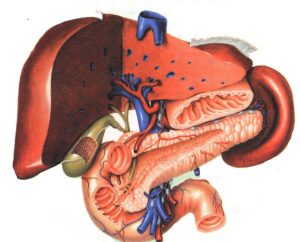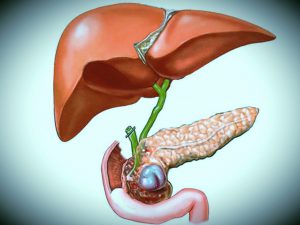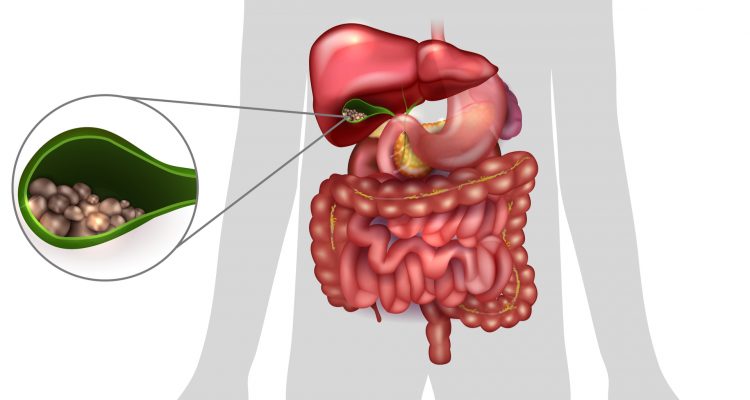The risk of gallbladder inflammation increases with stones in the bladder and bile ducts. The risk group for cholecystitis includes women aged 40 and older, they get sick 5 times more often than men. Cholecystitis threatens with serious complications – peritonitis and sepsis. Knowing the symptoms of cholecystitis will allow you to immediately consult a doctor at the first warning signs.
What is cholecystitis
Cholecystitis is a collective medical term that denotes inflammatory processes in the gallbladder that are different in etiology, nature of the course and symptoms.
Why do you need a gallbladder
The gallbladder is similar in size to a small chicken egg. It is a hollow organ inside, which, when filled with bile, takes on a different shape. It consists of a body, neck and bottom.
The main task of the gallbladder is the accumulation and excretion of bile when food enters the digestive system. Any violation in his work instantly affects the general well-being of a person.
Bile is produced by liver cells – hepatocytes, this process goes on continuously (Fig. 1). Bile has a liquid consistency, a specific yellow-green color, a recognizable smell and a bitter taste. This liver secretion plays an important role in digestion: it breaks down fats and regulates metabolism. Bile activates pancreatic enzymes and neutralizes gastric acid.
Inflammation of the gallbladder is an urgent problem for residents of developed countries. Despite the unconditional success of modern medicine in the diagnosis and treatment of cholecystitis, the incidence rate is steadily increasing from year to year. If a few decades ago the disease was considered characteristic of older people, now there is a tendency towards its gradual “rejuvenation”.
According to the number of diagnoses in the group of diseases of the digestive system, cholecystitis is second only to acute appendicitis. Along with the general increase in morbidity throughout the world, there is an increase in the number of patients with a complicated form of pathology. Since the disease significantly reduces the quality of life of people, WHO speaks of it in a social context.
In most patients, inflammation is associated with the presence of gallstones, in other words, with gallstone disease. Among the patients, women over 40 predominate; they suffer from cholecystitis 3-5 times more often than men. The disease is typical for residents of developed countries, which is associated with dietary habits and lifestyle.
Causes
Scientists still continue to argue about the causes of cholecystitis. The most popular theory associates the pathology with an infectious lesion, since bacteria in the gallbladder are found in about half of the patients during examination.
According to this theory, inflammation of the gallbladder begins when pathogenic microflora enters it – staphylococcus, streptococcus, Escherichia coli and some other bacteria. Sometimes the cause of cholecystitis is worms, fungi, anaerobic bacteria, hepatitis viruses. In more rare cases, cholecystitis develops against a background of allergies or poisoning.
The infection enters the gallbladder in different ways:
enterogenic – with food and drink during the digestion of contaminated foods;
hematogenous – during dental or other operations using non-sterile instruments, during blood transfusion or injections with a contaminated needle;
lymphogenous – through the lymphatic capillaries and other structural elements of the lymphatic system.
There are other opinions about the nature of cholecystitis, for example, about the occurrence of an inflammatory process in the biliary tract and gallbladder due to impaired blood circulation in the walls due to vascular thrombosis. The destructive process begins against the background of ischemia of the cystic artery.
Another theory links cholecystitis with abnormal liver function, which lead to pathological changes in the structure of bile. As a result, the digestive system ceases to play an antioxidant protective role, and inflammation begins in the gallbladder.
Cholecystitis usually develops with stagnation of bile in the gallbladder. Violation of the utilization of bile can be due to various factors:
The presence of stones that block the bile ducts and prevent the outflow of bile. The calculi often have sharp edges that injure the mucous membrane. Places of scratches and ulcers are the entrance gate for pathogenic microflora.
Violation of the contractile function of the gallbladder and a decrease in its tone. As a result of dyskinesia, bile does not completely leave the organ, and its stagnation provokes an inflammatory process and the formation of solid particles.
Congenital pathologies of the structure of the gallbladder – curvature, constriction, scars, narrowing of the ducts, which impede the outflow of bile.
The presence of other diseases of the gallbladder and ducts – tumors, cysts and other pathologies. Any tumor can compress the ducts and obstruct the flow of bile.
Cholecystitis treatment
Treatment of the disease is carried out in a comprehensive manner. The goal of therapy is not only to relieve symptoms and alleviate the general condition of a person, but also to cope with the cause of bile stagnation and prevent possible relapses.
Gallbladder and biliary tract lavage (tubage)
Tubage is a simple and popular gallbladder lavage procedure that is easy to do at home. It helps relieve pain and eliminate bile stagnation. This is an alternative wellness technique that can be used only after a comprehensive examination and receiving recommendations from the attending gastroenterologist.
To cleanse the gallbladder and ducts, mineral water, herbal preparations with a choleretic effect, magnesia, xylitol are used. Any liquid must be warmed up to 40-450C, and gas must first be released from the mineral water.
During the procedure, the person should lie on his right side, bending his knees slightly, and put a heating pad under his right side. 2 cups of the liquid prepared for tyubage should be drunk in small sips for 30-40 minutes and calmly lie down for another half hour before the desire to go to the toilet appears.
The course of treatment lasts 2-3 months with the procedure 1-2 times a week.
For the best effect, a strict diet should be followed during treatment, refusing to eat fried and fatty foods, hot spices, marinades, and muffins.
Tubage improves gallbladder motility and is used to prevent the formation of stones. The procedure is indicated not only for chronic cholecystitis, but also for pancreatitis and liver problems.
Important! Tubage can be performed only in the absence of stones in the gallbladder, confirmed by the results of ultrasound. Otherwise, the procedure can provoke the movement of stones and significantly worsen the condition.
The procedure is contraindicated in the following conditions:
the presence of stones in the gallbladder;
peptic ulcer;
period of exacerbation of cholecystitis and any other chronic pathologies of internal organs;
inflammatory process in the body of any localization;
pregnancy;
menstruation;
hepatitis and a number of other diseases.
Medicines for cholecystitis
Drug therapy is the basis for the complex treatment of cholecystitis. In chronic non-calculous form, conservative methods are sufficient. During an exacerbation, the main task of the prescribed drugs is to reduce pain and eliminate the focus of inflammation.
Drug therapy includes:
broad-spectrum antibacterial drugs;
means for relieving symptoms of body intoxication;
non-steroidal anti-inflammatory drugs;
antispasmodics https://en.wikipedia.org/wiki/Antispasmodic;
enzyme preparations to improve digestion;
choleretic agents.
The choice of drugs, their dosage and duration of administration is the competence of a gastroenterologist. Any self-medication for cholecystitis is unacceptable.
